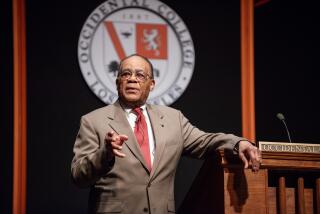Samuel P. Massie Jr., 85; Taught at Naval Academy
- Share via
Samuel P. Massie Jr., a chemistry professor who was the first African American to teach at the U.S. Naval Academy, died April 10 in Laurel, Md. He was 85 and had dementia.
Massie considered himself first and foremost a teacher, though he also gained widespread recognition for his work in chemistry.
As a young man studying for his doctoral degree, Massie worked on the Manhattan Project with scientists making liquid compounds of uranium for the atomic bomb. He conducted pioneering silicon chemistry research and investigated antibacterial agents. With two midshipmen and colleagues from the Walter Reed Army Institute of Research, he was awarded a patent for chemical agents effective in battling gonorrhea.
He received awards for research in combating malaria and meningitis, worked on drugs to fight herpes and cancer and developed protective foams against nerve gases.
Massie also received recognition for encouraging African American and other minority students to pursue science careers.
“Many people, some of them teachers, feel that science and mathematics are not for the common student,” he once said. “They are wrong. The depth of use may vary, but the principles remain understandable to all of us.”
Samuel Proctor Massie Jr. was born in North Little Rock, Ark., the son of two schoolteachers. He skipped several grades and graduated from high school at 13.
Because of his age and family finances, he worked in a grocery store for a year before enrolling in Dunbar Junior College in Little Rock. After graduating, he wanted to attend the University of Arkansas, but the doors were closed to black students.
He went on to what is now the University of Arkansas at Pine Bluff and graduated cum laude in 1936. He received a master’s degree in chemistry from Fisk University in 1940. In 1941, Iowa State University accepted him in its doctoral program in organic chemistry but would not allow him to live on campus or use the same science lab as the white students.
“The laboratory for the white boys was on the second floor next to the library,” Massie recounted. “My laboratory was in the basement next to the rats. Separate but equal.”
With the outbreak of World War II, he joined a special research team at Iowa State working on the Manhattan Project. In 1946, he received his doctorate.
Afterward, Massie began his career in academia. He became a chemistry professor at Fisk but left after one year when he was named chairman of the chemistry department at Langston University in Oklahoma. He returned to Fisk in 1953 and continued his research of phenothiazine, which was used in treating psychiatric disorders and in cancer therapy. He wrote a landmark article on the subject. From 1963 to 1966, Massie was president of what was then North Carolina College at Durham.
President Johnson then tapped him for a chemistry professorship at the Naval Academy. He remained at the academy for nearly 30 years, until his retirement as a professor emeritus in 1993. In 2002, the U.S. Department of Energy sponsored the Samuel P. Massie Chairs of Excellence, a $14.7-million grant awarded to 10 universities to enhance “groundbreaking environmental research and the production of top-level graduates.”
Massie’s survivors include three sons, six grandchildren and a great-granddaughter.
More to Read
Sign up for Essential California
The most important California stories and recommendations in your inbox every morning.
You may occasionally receive promotional content from the Los Angeles Times.












